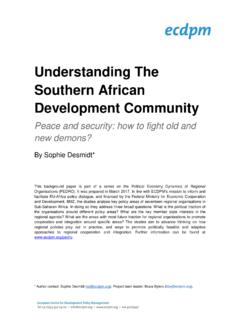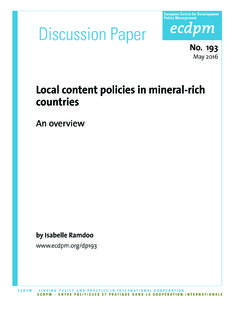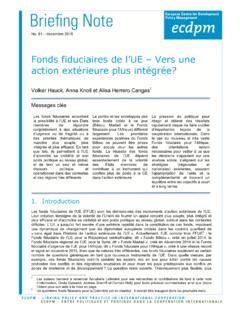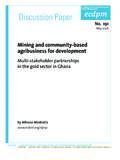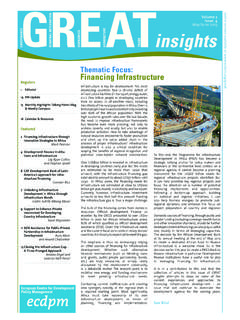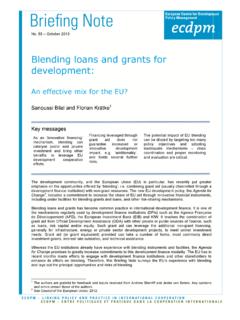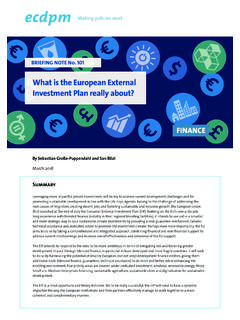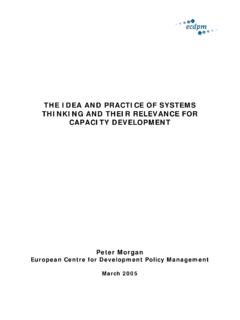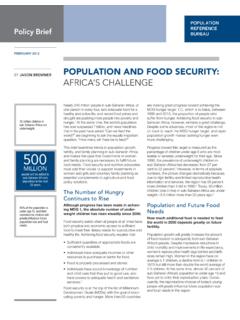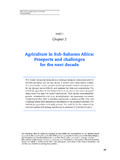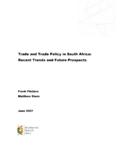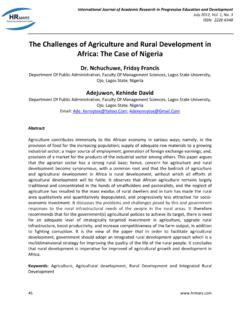Transcription of Understanding the political economy of the EAC in …
1 Understanding the political economy of the EAC in the agricultural sector Private sector ambitions facing political headwinds By Fabien Tondel*. This background paper is part of a series on the political economy Dynamics of Regional Organisations (PEDRO). It was prepared in March 2017. In line with ECDPM's mission to inform and facilitate EU-Africa policy dialogue, and financed by the Federal Ministry for Economic Cooperation and Development, BMZ, the studies analyse key policy areas of seventeen regional organisations in Sub-Saharan Africa. In doing so they address three broad questions: What is the political traction of the organisations around different policy areas? What are the key member state interests in the regional agenda? What are the areas with most future traction for regional organisations to promote cooperation and integration around specific areas?
2 The studies aim to advance thinking on how regional policies play out in practice, and ways to promote politically feasible and adaptive approaches to regional cooperation and integration. Further information can be found at * Author contact: Fabien Tondel Project team leader: Bruce Byiers Table of contents Table of contents 2. 1. Introduction 3. 2. political traction for the EAC and a regional agricultural policy 4. Institutional factors 4. Implementation challenges 7. Actors influencing the EAC agricultural and food security policy 10. 3. political interests of the member states in the EAC and its agricultural policy 12. Financial contributions 12. Interests in the agricultural sector 13. 4. What are the areas of the agricultural and food security policy with most traction for regional cooperation?
3 17. Bibliography 20. 2. 1. Introduction The East African Community (EAC) has quickly reached a relatively deep level of regional integration, notably in the trade and transport sectors (Mathieson, 2016). The Africa Regional Integration Index Report 1. 2016 ranked the EAC first among all African regional economic communities (RECs) in terms of progress on regional integration. The Treaty for the Establishment of the East African Community was signed in November 1999 and entered into force in July 2000 following its ratification by the original three Partner States, Kenya, Tanzania and Uganda. Burundi and Rwanda ratified the Treaty of the EAC in June 2007. 2. and became in effect full members of the Community in July 2007. South Sudan joined the EAC in 2016. According to its Treaty, the EAC aims at political , economic, social and cultural cooperation and integration, 3.
4 To attain prosperity and diversify and improve the economic competitiveness of East African economies. Following the Treaty, the EAC established a customs union in 2005 and a common market in 2010, 4. opening domestic economies to the movement of goods , services, people and capital within the EAC. Talks about forming a monetary union are currently taking place. Agricultural development has been a priority policy objective of the East African Community (EAC) since its establishment. It is a major component of EAC economies, representing 36 percent of GDP on average 5. and a large share of employment. Agriculture is thus deemed a pillar of the EAC agenda. Despite its importance, poverty levels are still high in rural areas due to the poor performance of the sector. Smallholder farmers represent the largest share of the sector, using most of the arable land and producing most of crop and livestock products.
5 Low productivity, stemming from a lack of access to markets, credit and technology, is the major challenge of the East African agricultural sector. This is exacerbated by volatile food and energy prices. The performance of the agricultural sector falls short of the rapidly increasing demand for food arising from demographic growth, rising incomes and urbanisation. Migration from rural to urban areas combined with rapid population growth entails an increase in demand of 5% to 10% per annum. In the future, the growth in food consumption will be the main driving force behind the development of a market-oriented agricultural sector in the region. This desk study examines the various factors and actors that have shaped the formulation and implementation of the EAC agricultural policy.
6 It tries to explain why this policy has been implemented in a certain way, and in particular what factors have constrained its implementation process. It is structured as follows: Section 2 describes the agricultural policy agenda of the EAC and its institutional capacities, and it assesses the political traction that this agenda has had (or not); Section 3 analyses the drivers of agricultural policies at the national level and how those (including Partner States' interests) may have affected the regional agricultural policy agenda; lastly, Section 4 discusses the areas of the regional agricultural policy agenda that have the most potential for agricultural development effectiveness. 1. This report was produced by the African Union Commission (AUC), the African Development Bank (AfDB) and the United Nations Economic Commission for Africa (ECA).
7 2. In formal terms, the EAC is an intergovernmental organisation involving the Republics of Burundi, Kenya, Rwanda and South Sudan, the United Republic of Tanzania, and the Republic of Uganda. 3. See also the East African Community Vision 2050: Regional Vision for Socio-Economic Transformation and Development (Arusha, August 2015). 4. The Common Market essentially provided for the removal of customs duties. 5. Agriculture contributes as much as 42%, 28%, 25%, 28% and 32% to the GDP in Burundi, Tanzania, Uganda, Kenya and Rwanda, respectively. 3. 2. political traction for the EAC and a regional agricultural policy Institutional factors A regional agenda Agricultural development has been a priority policy objective of the East African Community (EAC) since its establishment.
8 The Treaty of the EAC set these agriculture-related objectives: a common agricultural policy; an increase in food production and food self-sufficiency in the community; reduced post-harvest 6. losses and improve food processing. The Treaty also proposed specific areas of intervention in agriculture. The main agricultural policy documents of the EAC include: - The East African Community Agriculture and Rural Development Policy (ARDP, 2006): this document constitutes the actual common agricultural policy of the EAC; it indicates the general orientation of EAC policy in this sector and provides a framework for public intervention in favour of agricultural development and related sectors at the regional level. - The East African Community Agriculture and Rural Development Strategy (ARDS, 2006): this document outlines specific interventions in four thematic areas (production, trade, supporting infrastructure and services, and natural resources management) over the period 2005-2030; it also contains provisions for institutional arrangements supporting the implementation of the ARDP.
9 More recently, the 4th EAC Development Strategy 2011/12-2015/16 raised the priority given to agriculture 7. and food security compared to previous Development Strategies. This reflected an intent to reap the development potential of the agricultural sector through structural change and technological modernisation. To operationalize the strategy, the EAC adopted the EAC Food Security Action Plan (FSAP). This covers numerous intervention areas such as agricultural production, agro-food processing, research and innovation, agricultural inputs, plant and animal disease control, food quality and safety, trade, agricultural risk management, emergency preparedness and response in arid and semi-arid regions and pastoralists 8. communities. Table 1 summarises the major components of the FSAP.
10 Table 1: Components of the FSAP. Intervention Implementation status EAC Food Security and Nutrition Policy (FSNP) The FSNP was adopted in 2014. The FSNP. Implementation Strategy has been formulated in 2016. EAC Livestock Development Policy Stakeholders at the technical level have validated the policy document; approval by the Sectoral Council on 6. Those areas include: Seed production and distribution; livestock production and marketing; plant and animal diseases control; irrigation and water catchment area management; and food and nutrition security (see Treaty Articles 105, 106,107,108,109 and 110 on agriculture and food security. 7. The EAC operates on the basis of quinquennial Development Strategies. More recently, the EAC Vision 2050 (2015). also put agriculture among the priority sectors.)

